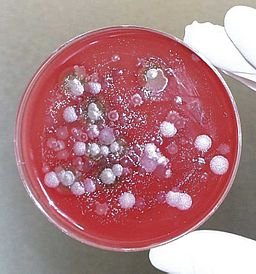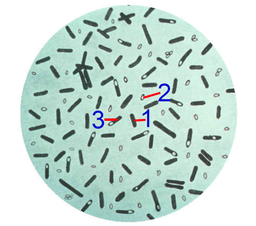LET'S TALK ABOUT BIOTERRORISM, SHALL WE?
ORIGIN OF BIOTERRORISM
History of Biowarfare
 Source: Centers for Disease Control, United States [Public domain], via Wikimedia Commons
Source: Centers for Disease Control, United States [Public domain], via Wikimedia CommonsThe Rise of Bioterrorism
Even after the ratification of the BWC, a large number of countries went on to develop, produce and test biological agents for military purposes. Since the 1980s, terrorist groups have increasingly considered bioweapons as a highly destabilizing tool for civil society and economy.
The large scale advent of biotechnology and the reduced difficulty in production of genetically modified organisms have made the potential creation of multi-drug resistant pathogens with enhanced virulence factors possible. The use of biological agents in the last decades is mainly attributable to terrorist groups, more or less isolated, who used bioweapons as a strategy to defend extremist religious ideas by striking civilian populations or sensible government targets.
Humans, regrettably, have used all the available technologies for destruction of enemies as well as for beneficial purposes throughout history. Biological agents are one of
them.
History dates back to the eighteenth century (1754 – 1767) when British distributed blankets used by small pox patients to the Native Americans and the mortality in some tribes were as high as 50%. Japanese also used smallpox weapon against the Mongolians & Chinese during II world war.
The preferred agents are bacillus anthracis, yersinia pestis, small pox virus or any genetically engineered organism that can survive, express or perpetuate in the natural environment.
BWs are clubbed with the nuclear and chemical weapons. However, bws are very different, while nuclear & chemical attacks cause their damage maximally immediately, biological attacks become manifest after sometime.
The attraction for bws is attributed to their following features:
• Low production costs - called the "poor man's atomic bomb/ "poor man's weapons of mass destruction",
• Easy access to a wide range of disease producing biological agents.
• Non -detection by routine security system and easy transportation.
• High fatality: biological toxins are among the most toxic agents known e.g. the quantity of botox in the dot of an ‘i’ is enough to kill ~10 people
BWs have the added advantage of destroying an enemy while leaving his infrastructure intact as booty for the winner.
Tricothecenes, a type of Mycotoxin, is supposed to have been used in the famous yellow rain incident, which still is a subject of debate with no conclusive established proof, though it's thought to be implicated at least in some.
A case was documented in the US where a gastroenterologist was convicted of attempting a second-degree murder by injecting his former girlfriend with blood or blood-products obtained from an HIV-1 (Human immunodeficiency virus-1) infected patient under his care.
Other recent well publicized biocrimes include use of “ricin” in Europe for the assassination of a Bulgarian exile, a laboratory worker intentionally infecting co-workers in Texas with Shigella dysenteriae, and use of Salmonella Typhimurium in Oregon by contaminating salad bars in local restaurants which was politically motivated. The most well known attack of bioterrorism in the present century is the use of anthrax spores in New York in October 2001 .
Bioterrorism Agent Categories
Bioterrorism agents can be separated into three categories, depending on how easily they can be spread and the severity of illness or death they cause. Category A agents are considered the highest risk and Category C agents are those that are considered emerging threats for disease.
Category A
These high priority agents include organisms or toxins that pose the highest risk to the public and national security because:
• They can be easily spread or transmitted from person to person
• They result in high death rates and have the potential for major public health impact
• They might cause public panic and social disruption
• They require special action for public health preparedness.
Category B
• These agents are the second highest priority because:
• They are moderately easy to spread
• They result in moderate illness rates and low death rates
• They require specific enhancements of CDC's laboratory capacity and enhanced disease monitoring.
Category C
These third highest priority agents include emerging pathogens that could be engineered for mass spread in the future because:
• They are easily available
• They are easily produced and spread
• They have potential for high morbidity and mortality rates and major health impact.
MICROBIOLOGY AND CLINICAL ASPECTS OF POSSIBLE AGENTS OF BIOTERRORISM
Botulinum neurotoxin:
Botulinum neurotoxin (BoNT) is derived from the Clostridium botulinum bacterium and causes botulism. It is the most potent toxic substance currently known.
Exploitation as a bioweapon in the past
BoNT was initially used as a biowarfare agent by the Japanese during World War II. Thereafter, it was produced by other countries as well, including the USA, USSR, and Iraq.
In the 1990s, the Japanese cult Aum Shinrikyo attempted to launch several terror attacks with BoNT,
but all of them failed.
Given the ease of BoNT production, there is a risk of its future use for malicious purposes.
Toxin source

Source: CDC,Wikimedia Commons CC BY-SA 4.0
Clostridium botulinum is a gram-positive motile rod. There are seven serotypes of the bacterium (designated A–G) distinguished by the antigenic characteristics of the neurotoxins they produce. Serotypes A, B, E, and in rare cases, F have been described as causing disease in humans.
Pathogenesis
Natural BoNT poisoning usually occurs by ingestion of formed toxin as a result of inappropriate preparation and preservation of certain food items (food-borne botulism), or sometimes by spores germinating and producing the toxin in the immature intestinal tract of infants (infant botulism).
Natural poisoning can also occur as a consequence of bacterial overgrowth in necrotic wounds (wound botulism) or in individuals with a gastrointestinal disease (adult colonization botulism). Inhalational exposure to BoNT aerosol is regarded as a possible bio-terror threat. In any case, the disease develops within 12–36 h from the moment the toxin enters the body, regardless of the route of exposure.
Mechanism of action and resistance
BoNT is active in the neuromuscular junctions of the peripheral nervous system. It acts by blocking acetylcholine release from the presynaptic nerve endings, causing weakness and paralysis of the corresponding muscles. The interference with synaptic activity is prolonged owing to the long half-life of the toxin.
The toxin can be inactivated in a temperature of 85 °C for a period of 5 min, by exposure to the sun for 1–3 h, or by using chlorine.
Clinical manifestations
All forms of botulism lead to the same clinical syndrome of symmetrical cranial neuropathy, including diplopia, ptosis, dysphagia, xerostomia, dysphonia, or dysphasia, in combination with symmetrical descending paralysis. In most cases, there is no fever.
Occasionally, gastrointestinal symptoms, such as abdominal pain, nausea, vomiting, or diarrhea, may precede the neurological presentation. The paralysis may progress to include the respiratory muscles with subsequent respiratory failure.
Diagnosis
The clinical diagnosis of botulism is based mainly on medical history and physical examination. In naturally occurring botulism, the bacteria can be isolated from stool, blood, or food samples. In a bio-terror scenario, when individuals are exposed to an aerosolized toxin, traditional microbiological tests are not helpful.
Gene detection methods are an option if the offending substance contains bacterial residue. The gold-standard diagnostic test is the indirect mouse neutralization bioassay.
The main disadvantage of this test is its 96-h duration and lack of sufficient sensitivity.
A new method of endopeptidase-mass spectrometry is gaining credibility as a promising method that addresses the limitations of the mouse assay.
Electromyography can strongly support the clinical diagnosis showing a typical pattern for botulism. Findings on routine blood tests and brain imaging are usually normal, but may serve to rule out other diagnoses.
REFERENCES
CDC 2006
Frinking et al 2015
Madad et al 2014
Berger et al 2016
Kumar et al 2011
Varun et al 2012
Hello! I find your post valuable for the wafrica community! Thanks for the great post! @wafrica is now following you! ALWAYs follow @wafrica and use the wafrica tag!
CONGRATULATIONS....
YOUR AWESOME POST WAS SELCECTED IN THE @wafrica DAILY CURATION
COURTESY: @julietisrael
Nice Job. 👍
Congratulations! This post has been upvoted from the communal account, @minnowsupport, by IamChijamz from the Minnow Support Project. It's a witness project run by aggroed, ausbitbank, teamsteem, theprophet0, someguy123, neoxian, followbtcnews, and netuoso. The goal is to help Steemit grow by supporting Minnows. Please find us at the Peace, Abundance, and Liberty Network (PALnet) Discord Channel. It's a completely public and open space to all members of the Steemit community who voluntarily choose to be there.
If you would like to delegate to the Minnow Support Project you can do so by clicking on the following links: 50SP, 100SP, 250SP, 500SP, 1000SP, 5000SP.
Be sure to leave at least 50SP undelegated on your account.